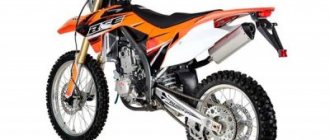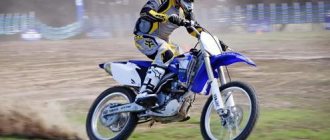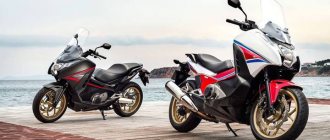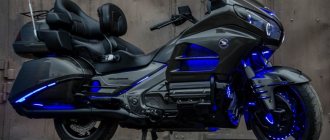Test Honda CRF110F 2022 Kawasaki KLX110R 2022 Yamaha TT-R110E 2021
Did you think we wouldn't make it? We had our doubts too, but nevertheless managed to make the main comparison of the year in the most important cubic capacity among off-road motorcycles... 110 four-stroke cubes, of course!
Honda CRF110F 2022 Kawasaki KLX110R 2022 Yamaha TT-R110E 2021
In 2022, 110s were sold like hot cakes, despite the fact that these Japanese-made pit bikes (or mini-cross bikes, mini-enduro, trail bikes, whatever they are called) are quite expensive, so you have to take their purchase seriously. This means that the comparison will be almost no joke!
So we started by taking the Honda CRF110F, Kawasaki KLX110R and Yamaha TT-R110E, weighing them and putting them on the dyno. Then they brought them to the training track and put three adults, established guys on them, who don’t need to justify themselves to anyone for the fact that they like to ride pit bikes, and asked to evaluate these motorcycles as if they were going to have a race with them with good prizes.
All three motorcycles have very basic suspensions without any adjustments. Yes, you heard right - even the spring preload to adjust the sag does not change. But to keep things from looking too sad, we replaced the stock handlebars with ODI Pit Bike 110s with quick-release grips on them. We pumped the same atmosphere into the stock tires, filled them with the same 92-grade gasoline - and off we went!
Dyno stand
Do you think putting a 110 on a dyno is a little too much? But it shows something - and it’s this “something” that we will compare. True, with such small values, the role of error is large, and even half a horse of a difference in the form of percentages can look like a colossal advantage... In general, in terms of numbers, the Yamaha TT-R110E is a clear leader in power, but this power is available at high speeds. And in terms of torque it has second place. The Kawasaki KLX110R is second in horsepower and last in traction. Surprisingly, the only fuel-injected motorcycle, the Honda CRF110F, has the least horsepower but produces the most powerful thrust.
Scooter rider
With a sleek, attractive body design and comfortable seating for two, the Honda Dio 110 is the ideal scooter for daily commuting, shopping or country trips. Large under-seat storage and large 5.2-litre fuel tank. Add to this the fact that this scooter is universal.
Equipped with an efficient and reliable 108cc four-stroke engine with PGM-FI fuel injection and electric start. With the added idle feature, the Honda Dio 110 becomes even more economical, reducing fuel consumption and noise while waiting at stops, such as at traffic lights.
The Honda Dio 110 features a Combined Braking System (CBS) that connects the front and rear brakes to provide fast, consistent braking regardless of rider experience or road conditions. The Dio 110 also offers confident handling and good maneuverability thanks to its rigid and lightweight frame.
Comfort and convenience of Honda dio 110
Designed to be comfortable for both rider and passenger, the ergonomic one-piece seat is set at a height of 760mm, giving plenty of legroom, while also making the scooter easy to handle. The Honda Dio 110 features a stable, highly agility chassis and the handlebar position has been carefully designed to give the rider confident control.
With a glove compartment large enough for shopping, waterproof security locks, you can also store a helmet in the trunk of your scooter in addition to your shopping.
Sharp lines and aggressive headlights make the Honda Dio 110 a striking and modern scooter.
Honda Dio 110 is well suited for training. Ideal for training scooter and motorcyclist riders.
Technical characteristics of Honda dio 110
Manufacturer: Honda Model: Dio 110 Power: 110cc Engine: Single cylinder 4-stroke fuel injected Starter: Electric Transmission: CVT Belt drive Seat height: 755 mm Wheelbase: 1255 mm Front Tire: 80/90-14 14M/C × MT1. 85 Rear Tire: 90/90-14 14M/C × MT1.85 Front suspension: Telescopic fork Rear suspension: Swingarm Block Front brakes: 220mm disc Rear brakes: 130mm drum Dry weight: 102kg Max power: 6.2kW/8000 rpm Maximum torque: 8.7 Nm / 6500 rpm Cooling: Air cooled Length: 1845 mm Width: 670 mm Maximum speed: 110 km/h Fuel consumption: 2-2.5 l. Fuel capacity: 5.2 liters
Honda CRF110F 2022
In the nineties and noughties, when fifty dollars took over the world of motocross, the CRF50F simply dominated the market. Today's CRF110F, the most technically advanced of the three 110s, with an injector and a two-spar steel frame, like “big” motorcycles, has also become for many the standard of a large pit bike, on which you can do quite adult things with childish spontaneity.
Honda CRF110F 2021
Our riders noticed one nice feature about the Honda CRF110F: extremely smooth traction. Thanks to the injector, the throttle response is clear, confident, but not harsh. Ideal, in a word, for beginners who are learning to ride, but also very convenient for those who are more prepared, especially on uneven roads. Additionally, the Honda CRF110F doesn't have to be revved too much to get maximum traction, but the other two bikes always feel under-torqueed, especially in corners. This model is the heaviest of the three, but none of our testers, including the girls, complained about it or said the Honda felt bulky.
Yamaha TT-R110E 2022
The Yamaha TT-R110E replaced the TT-R90 in 2008. It was the first 110 to have the magic engine start button that they now have on all of them. In terms of power, things are a little more complicated than with the Honda: the Yamaha TT-R110E has to be twisted harder, but for more advanced riders this is rather a plus. Despite the fact that the 110 cc engine is not enough for pronounced pickup from the bottom (or from any other speed), its top-end power is quite impressive, but at the same time controllable. The Yamaha TT-R110E feels faster than the Honda, but it is also a little more difficult to ride exactly fast. The difference in torque is almost imperceptible, especially for lighter riders.
Yamaha TT-R110E 2021
By the way, it is worth noting that the Yamaha TT-R110E is the lightest motorcycle of the three. Its weight is 72.5 kg, that is, it is 4.5 kg lighter than the CRF. Therefore, the Honda's advantage in torque figures is offset by its slightly greater weight on the track. In terms of ergonomics, the Yamaha TT-R110E is visually quite large, almost a “real” motorcycle, but due to the ill-conceived seat, the rider sits too deep, and, accordingly, in a more crooked position. For children, such a saddle will probably be more comfortable, but for adults it is a clear disadvantage. In addition, compared to the other two motorcycles, the Yamaha TT-R110E suspensions are softer.
Honda Dio 110 EBJ-JF31 scooter review
Although the 50cc Dio range of scooters is no longer in production, this does not mean that Dio is finished. In 2011, a new series of maxi-scooters Honda Dio 110 EBJ-JF31 with a four-stroke single-cylinder 110 cm³ air-cooled engine was presented to the public. This scooter has a sporty design, but the developers did not forget about driver comfort. The trunk volume is 18 liters - which, however, is not surprising, because the scooter has increased dimensions and is designed to carry two passengers.
The scooter is economical (on 1 liter of fuel you can travel 52 km at a speed of 60 km/h) and highly environmentally friendly, and has a smooth ride. Large 14-inch wheels provide a comfortable ride and good stability both in urban conditions and on the highway. Of course, the Dio 110 has a combined braking system with anti-lock braking system.
Dio 110 is available in 5 color options: blue, metallic grey, red, black pearl and pearl white.
Specifications
Engine: Engine type – JF31E, displacement 107 cc. see Number of cylinders – 1. Number of strokes – 4. Cooling system – air cooling. Maximum engine power – 8.4 hp. at 8250 rpm. Torque – 0.89 kg*m / 6500 rpm. Compression ratio – 9.5. Transmission – V-Matic CVT. Ignition - dynastarter. The front wheel tire size is 80/90-14. The rear wheel tire size is 90/90-14. Gas tank volume – 5.5 liters. Maximum speed – 110 km/h. Chassis: Front wheel suspension type – telescopic. The rear wheel suspension type is pendulum. The front wheel brake type is disc. The rear wheel brake type is drum. Size and weight: Base – 1255 mm. Length – 1845 mm. Width – 670 mm. Height – 1090 mm. Seat height – 755 mm. Ground clearance – 120 mm. Total weight – 103 kg.
Features and Benefits
Honda Dio 110 has a catchy, sporty appearance, designed mainly for young buyers. The design, on the one hand, is simple, on the other hand, it leaves no one indifferent.
The scooter is powered by a newly designed 110cc 4-stroke air-cooled engine. It uses the company's latest development - the PGM-FI (programmed fuel injection) system, designed for the highest operational requirements. This system will help start the engine even when the battery is low or at low temperatures.
The exhaust system uses a mandatory catalytic converter, which reduces the emission of harmful gases into the atmosphere.
The scooter is equipped with large 14-inch wheels with aluminum alloy rims, providing high comfort in any road conditions.
The large 18-litre underseat rack, front pocket and cargo hooks allow you to carry a variety of bags and other items.
As already mentioned, the Honda Dio 110 has enough power to carry a passenger. The scooter has folding side foot rests.
The scooter has various anti-theft systems.
Please note: This article and the images in it are subject to copyright. Partial or complete reproduction on other resources without permission is prohibited.
Kawasaki KLX110R 2022
For decades, this model has been the gold standard in the 110k category, as it is one of the first motorcycles in this class. However, over the years, Kawasaki has changed almost nothing about it, except for the design. Engine-wise, the Kawasaki KLX110R isn't too different from the other two models, but it's not as smooth as the Honda and runs out of steam a little earlier than the Yamaha. All testers, both adults and young, noticed some dullness when opening the throttle sharply.
Kawasaki KLX110R 2021
All three models have suspensions that are too soft for adults, but the Kawasaki KLX110R outperforms the competition in a bad way. However, breaking the suspensions on all three is not at all difficult, so driving them turns into a fun competition in avoiding obstacles and driving carefully so as not to overload the suspensions and lose control.
Comparison of Lead AF20 and Lead AF48
Honda Lead AF48 is a more recent model, production of which began in 1998. Compared to the AF20, it has slightly larger dimensions: length – 1795 mm, width – 720 mm, height – 1060 mm. The wheelbase size of the AF48 is 1255 mm, which is 20 mm longer than that of the AF20. The weight of the Lead AF48 is 91 kg, which is 7 kg heavier than the AF20 scooter.
On the left in the photo is a 2002 Honda Lead AF48, on the right is a 1994 Lead AF20.
The Lead AF48 is equipped with a two-stroke single-cylinder AF48E engine with forced air cooling. Maximum speed – 60 km/h (electronically limited), maximum power – 5.9 hp at 6750 rpm, piston stroke – 39.3 mm, diameter – 40 mm. The rear suspension is a shock absorber with a spring assembly; a telescopic fork is installed at the front. In terms of brakes, the scooters are the same: front – disc, rear – drum.
Lead AF48 is more suitable for the city, as it has a telescopic fork. It handles road unevenness worse and will not be as good on bumps - the Lead AF20 is more suitable for the countryside.











